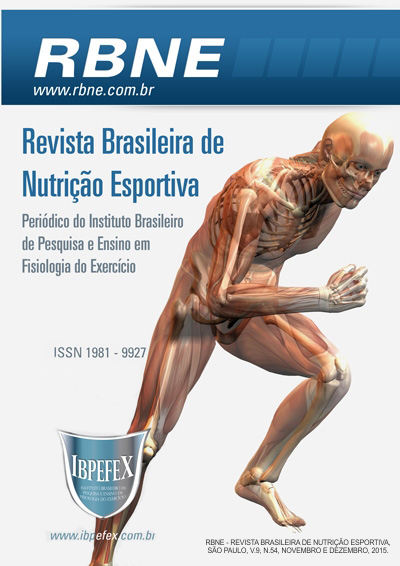Nutritional intervention and monitoring make a difference? Association between practitioners of physically active
Abstract
Introduction: Dietitians who acts in this action is faced with great challenges, and should combine the individual nutritional needs along with the ambition of performance in the short term. Objective: To assess the nutritional status and to correlate the results presented over time among practitioners that have nutritional monitoring.Materialsand Method: Retrospective longitudinal study. The records of 58 participants of both sexes of which 30 had nutritional counseling and the rest just practiced resistive exercise were evaluated. Collected the anthropometric, dietary, sociodemographic, physical activity (intensity and duration of monitoring has a physical educator). The statistical analysis was performed using descriptive statistics and tests of association. Results: The majority of the sample was female (75.9%). The correlation demonstrated that the majority of the sample used alcohol and tobacco belonged to the group that had no nutritional counseling and nutritional counseling individuals who had the most eutrophic presented in relation to body mass index, but greater amount of people with overweight and obesity me relation to arm circumference. The supplement with the highest consumption among practitioners was the Whey protein, followed by BCAA and Omega 3. The anthropometric development practitioners with nutritional counseling is mainly given waist circumference, arm circumference and body fat. Conclusion: All correlations were positive and statistically significant. The Practice of exercise combined with nutritional counseling entails satisfactory results both aesthetically and health itself.
References
-Adam, B.O.; Fanelli, C.; Souza, E.S.; Stulbach, T.E.; Monomi, P.Y. Conhecimento nutricional de praticantes de musculação de uma academia da cidade de São Paulo. Brazilian Journalof Sports Nutrition. Vol. 2. Núm. 2. p. 24-36. 2013.
-Bergman, R.N.; Stefanovski, D.; Buchanan T.A.; Sumner, A.E.; Reynolds J.C. Sebring, N.G.; Xiang, A.H.; Watanabe, R.M. A Better Index of Body Adiposity. Obesity. Vol. 19. p.1083-1089. 2011.
-Blackburn, G.L.; Thornton, P.A. Nutritional assessment of the hospitalized patient. Medical Clinics of North America. Philadelphia. Vol.14. p.1102-1108. 1979.
-Ferreira, L.N.; Junior, J.P.B.; Sales, Z.N.; Casotti, C.A.; Junior, A.C.R.B. Prevalência e fatores associados ao consumo abusivo e à dependência de álcool. Ciênc. saúde coletiva. Vol.18. Núm.11. 2013.
-Haraguchi, F.K.; Abreu, W.C.; Paula, H. Proteínas do soro do leite: composição, propriedades nutricionais, aplicações no esporte e benefícios para a saúde humana. Rev. Nutr. Vol.19. Núm. 4. 2006.
-Hirschbruch, M.D. Perfil dos profissionais e alunos de nutrição e de educação física interessados na área de nutrição esportiva. Âmbito Medicina Desportiva. Vol. 12. Núm. 107. p.5-12. 2006.
-Hirschbruch, M.D.; Fisberg, M.; Mochizuki, L. Consumo de suplementos por jovens frequentadores de academias de ginástica em São Paulo. Rev Bras Med Esporte. Vol. 14. Núm. 6. 2008.
-Jhons, D.; Boyce, J.; Jebb, S. Diet or Exercise Interventions vs Combined Behavioral Weight Management Programs: A Systematic Review and Meta-Analysis of Direct Comparisons. Journal of the Academy of Nutrition and Dietetics. Vol. 114. Núm.10. p. 1557-1568. 2014.
-Levy, M.D.; Loy, L.; Zatz, L. Policy approach to nutrition and physical activity education in health care professional training. The American Journal of Clinical Nutrition. Vol. 99. Núm. 5. p.11045-12015. 2014.
-Nascimento, S.L.; Pudwell, J.; Surita, F.G.; Adamo, K.B.; Smith, G.N. The effect of physical exercise strategies on weight loss in postpartum women: a systematic review and meta-analysis. International Journal of Obesity. Vol. 38. Núm. 5. p. 626-635. 2014.
-Norton, K.; Norton, L.; Sadgrove, D. Position statement on physical activity and exercise intensity terminology. Journal of Science and Medicine in Sport. Vol.13. p. 496-502. 2010.
-Oliveira, J.C.; Rodrigues, A.M.S. Fatores intervenientes no ganho da massa muscular. Anais do II Encontro de Educação Física e Áreas Afins. UFPI. 2007.
-OrganizaçãoMundial da Saúde. Physical status: the use and interpretation of anthropometry: report of a WHO expert committee. WHO Technical Report series. Núm. 854. Geneva.1995.
-Organização Mundial da Saúde. Report of a WHO Consultation on Obesity. Defining the problem of overweight and obesity. In: Obesity Preventing and Managing the global epidemic. WHO. Geneve.1998.
-Pereira, R.F.; Lajolo, F.M.; Hirschbruch, M.D. Consumo de Suplementos em academias de ginástica em São Paulo. Rev. Nutr. 16. Núm. 3. p. 265-272. 2003.
-Plowman, S.A.; Smith, D.L. Fisiologia do exercício para saúde, aptidão e desempenho. Rio de Janeiro. Guanabara Koogan. 2009.
-Santos, C.A. Tratamento nutricional da caquexia do câncer: evidências da utilização de aminoácidos de cadeia ramificada (BCAA) e Β-hidroxi-Β-metilbutirato (HMB). Especialização. GANEP Nutrição Humana. Minas Gerais. 2012.
-Silva, R.C.R.; Florence, T.C.M.; Machado, M.E.P.C.; Fernandes, G.B.; Couto, R.D. Indicadores antropométricos na predição de síndrome metabólica em crianças e adolescentes: um estudo de base populacional. Rev. Bras. Saúde Mater. Infant. Vol. 14. Núm. 2. 2014.
Authors who publish in this journal agree to the following terms:
- Authors retain the copyright and grant the journal the right of first publication, with work simultaneously licensed under the Creative Commons Attribution License BY-NC which allows the sharing of the work with acknowledgment of the authorship of the work and initial publication in this journal.
- Authors are authorized to enter into additional contracts separately for non-exclusive distribution of the version of the work published in this journal (eg, publishing in institutional repository or book chapter), with acknowledgment of authorship and initial publication in this journal.
- Authors are allowed and encouraged to post and distribute their work online (eg, in institutional repositories or on their personal page) at any point before or during the editorial process, as this can bring about productive change as well as increase impact and impact. citation of published work (See The Effect of Free Access).






